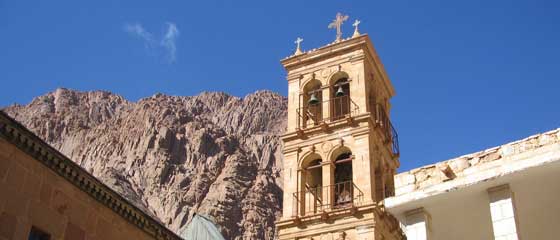
Saint Catherine's Monastery
Saint Catherine’s Monastery is located at the foot of Mount Sinai, just a twenty minute walk away from Saint Catherine’s Village. Any ascent of the mountain will begin at the monastery, as pilgrims dropped at the car park are required to walk alongside one side of the building’s imposing walls to reach the trail head.
The monastery is open for visitors between 9am and noon. It is closed on Fridays, Sundays and Greek orthodox holidays. Visitors are required to dress modestly i.e. cover knees and shoulders, however a limited number of long gowns are available free of charge at the door. Although entrance is free, there is a surcharge to visit the Narthex, which houses a small selection of the monasteries vast collection of Icons, artwork and manuscripts.
For those climbing Mount Sinai, the monastery is best visited at the end of the descent. If you watch sunrise from the summit, you’ll likely arrive back at the monastery’s entrance about 8am, in plenty of time to take your spot at the front of the queue.
If you’re staying in one of the Red Sea Resorts, you’ll find no shortage of travel agents organising day trips to the monastery.
Although most of the monastery remains closed to tourists, visitors are permitted to enjoy the following sections:
Justinian’s Wall - Upon first site the monastery more closely resembles a prison or castle than a place of worship. This is in no small part due to the imposing fortified wall built by the emperor Justinian in 527 AD. At 9ft thick and sixty feet high the walls more than served their intended purpose to protect the inhabitants from attacks by marauding Bedouin tribes.
Above the main entrance is a protruding wooden box where monks once lowered buckets to hoist up goods from traders rather than risk interacting with them directly. In 1801 Napolean ordered the restoration of these walls.
The Chapel of the Burning Bush – If you cast you mind back to Exodus 3:2 you may recall a bush ‘that burned with fire, but was no consumed’ through which God spoke to Moses. It was through this bush that Moses was instructed ‘Come now therefore, and I will send thee to Pharaoh, that thou may bring forth my people the children of Israel out of Egypt’ (3:10).
It is the presence of this bush that lead to the monastery being built in this location. The bush you see today, a rare species of the rose family Rubus Sanctus was allegedly transplanted here in the 10th Century AD when the Chapel was given a roof.
Saint Catherine’s Church - After walking past the Chapel of the Burning Bush, you will be ushered through to the Church, a granite basilica erected by the emperor Justinian between 542 and 551 AD. Around the twelve pillars (representing the months of the year), the interior is draped with dusty icons and art work in true orthodox style. The Sarcophagus next to the main alter allegedly stores the remains of Saint Catherine herself.
Moses Well – Upon leaving the church you’ll circumnavigate back to the entrance through which you came via Moses well. It was here that Jethro’s daughter Zipporah met Moses whom he later married.
Charnel House – Charnel house is located on the exterior of the rear (southern) monastery wall. You will need to exit the monastery and walk around to the rear side in order to view it. Due to the limited cemetery facilities at the monastery, the remains of the monks that lived and prayed here are later exhumed and placed at Charnel house. Through the barred doorway thousands of piled skulls and bones are clearly visible.
For More Information:
Map - To download, print and take you very own map of saint catherine's monastery
Yasas - for details of Greek Orthodox Holidays http://www.yasas.com/greek-holidays-holy-days.asp
More information about the story of Saint Catherine of Alexandria




